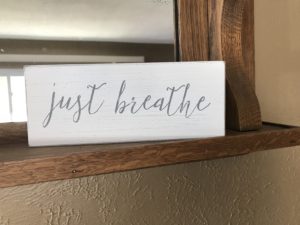When the word just is used as an adverb it means simply or only. Sometimes just is used to indicate lesser importance. The phrase “just breathe” might seem simple or inconsequential but the message of just breathe or simply breathe can benefit most people.
Breathing is a wonderfully complex and essential human function. We are not required to think about breathing because our brain and body take care of it. On the other hand, breathing is one the few physical processes that functions both voluntarily and involuntarily. When’s the last time you thought about your breathing?
In a society where a flat stomach is often considered attractive, it is not uncommon for adults to habitually hold in their stomach. This position restricts deep breathing and doesn’t take advantage of completely filling the lungs with air. This shallow breathing or chest breathing limits the use of the diaphragm and relies on secondary breathing muscles in the upper chest. Chest breathing is useful in situations like a sprint or race but it is not the best ongoing style of breathing as it can lead to tight and uncomfortable muscles in the neck, shoulders and chest.
Diaphragmatic breathing is also known as deep breathing, belly breathing or relaxed breathing. As the name implies, the diaphragm muscle is employed with the role of fully expanding the lungs. When breathing deeply, air expands the lungs and the lower belly rises. This is an efficient way to breathe which includes a full oxygen exchange and less stress on the shoulder, neck and upper chest muscles.
Not only does breathing affect the physical body, but it also correlates with psychological well-being. Frequent shallow breathing is associated with increased tension and anxiety whereas diaphragmatic breathing supports feelings of relaxation. Because just breathing is a constant function of healthy people as well as a powerful tool for relaxation, breathing is often used as a reminder or an anchor in mindfulness practices. Focusing on the breath does not require any special tools or instructions – it can be done anywhere, anytime without much fanfare.
So, how does one just breathe?
Breathing exercises can be done individually, or by listening to an instructor or an audio guide of a breathing exercise. Unlike when breathing is an automatic function, this mindful technique encourages taking a moment to be present, and to notice the physical sensations of completely inhaling and exhaling air in and out of the lungs. It is not uncommon for the mind to wander to other thoughts and distractions as you take a quiet moment of breathing. This is how the breath is used as an anchor. As the mind wanders, notice the distraction and then direct the attention back to the breathing. Afterwards, this exercise usually leads to the healthy default of deeper, slower breathing.
 To practice, here are a couple links to audio recordings of breathing exercises. Just listen, just follow the directions and just breathe. Can you spend five minutes each day just breathing?
To practice, here are a couple links to audio recordings of breathing exercises. Just listen, just follow the directions and just breathe. Can you spend five minutes each day just breathing?
- The Ohio State University Wexner Medical Center, Mindful Awareness of Breathing
- Dr. Benzo’s Mindful Breathing Lab at Mayo Clinic

